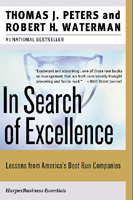
Secure Online Ordering Guaranteed!
|  |
In Search of Excellence : Lessons from America's Best-Run Companies
Thomas J. Peters and Robert H. Waterman


 |
 |
Retail Price: $16.95
LS Price: $11.85
You Save: $5.10 (30%)
Availability: Usually ships within 24 hours
Format: Paperback, 400pp.
ISBN: 9780060548780
Publisher: Collins
Pub. Date: Reprint edition March 2004 (1982)
Average Customer Review:




|
 |
 |
 |
Order This Book!




Secure Order Guarantee
Item No: 9780060548780
|

Excerpt from In Search of Excellence: Lessons from America's Best-Run Companies
Author's Note
As we look back on the two decades since the publication of Excellence, our main feeling is delight. Delight that so many people embraced the book. Delight in that we think we mainly got it right.
Our main detractors point to the decline of some of the companies we featured. They miss the point, which was to learn from those who'd had a long run of success, just as we learn from athletes in their prime. We weren't writing Forever Excellent, just as it would be absurd to expect any great athlete not to age. (The sheer longevity of Procter & Gamble's success is, however, intriguing.) And to the most hardheaded of our critics on this dimension: had you bought an "excellence index" when we published and held it through 2002, your total return would have been 1,300 percent, compared to around 800 percent for the Dow and 600 percent for the S&P 500.
What we take most pleasure in is sticking to our guns in putting several theory chapters up front: "The Rational Model," "Man Waiting for Motivation," and "Managing Ambiguity and Paradox." We told the readers they could skip these. Now we don't think so. They should be read and are just as relevant today as when we originally published.
In brief, we were saying the following (but don't skip the chapters). First, people and organizations are not "rational" in the ways strategy, business, and organization are typically taught. It's dangerous to try to force a simplistic and misguided rationality on the way we manage. You cannot just manage "by the numbers." Don't even think about it.
Second, most of the management systems that treat people as "factors of production," as cogs in an industrial machine, are inherently demotivating. People are wonderfully different and complex. Leaders need to set people free to help, not try to harness them.
Third, the world is a confusing place, full of ambiguity. The hardest thing to manage is the "soft stuff," especially culture. Yet without serious attention to the so-called soft stuff, leaders will fail.
Nor would we change our eight attributes of excellence, though we're perfectly aware that another researcher, looking at the same data, might pick a different set. These eight pretty clearly describe what's different about the top performers:
A bias for action. In its simplest terms, this says "get out there and try something." Just as you don't learn anything in science without experimenting, you don't learn anything in business without trying, failing, and trying again. The trick, and it's a tough one, is a common cultural understanding of what kind of failure is okay and what kind leads to disaster. But don't kid yourself. No amount of analysis, especially market research, will lead to true innovation.
Close to the customer. This may be the hardest to accomplish and perhaps where our sample of excellent companies -- IBM, Hewlett-Packard, K Mart, and even McDonald's -- got off the track. It's hard. There's so much to pay attention to inside an organization that has time to understand customers, especially when the set of customers includes distributors and wonderfully irrational end users. Yet Procter's skill at keeping everyone in the organization in close touch with customers, combined with a formidable innovative capability, may explain that company's incredibly long history of success.
Autonomy and entrepreneurship. Even if you're big, act small. Organizations are simply collections of people, and people don't relate well to big, abstract entities. If you want to understand the success of Johnson & Johnson, 3M, Wal-Mart, and the original HP, look to the fact that they organize themselves into small, relatively independent units, held together by common goals and cultural norms.
Productivity through people. As the youngsters say, "Duh!" What else counts in an organization except people? Everyone gives lip service to the importance of their people, yet only a few really treat them as other than cannon fodder. One of the best examples we've ever seen was Delta Airlines with its "family feeling," which was so special that in 1982 employees banded together to spend a total of $30 million in payroll deductions to give their employer its first Boeing 767, the Spirit of Delta. Sadly, Delta lost that family feeling, maybe when it merged with Western Airlines.
Hands-on, value-driven. The idea is simple. Figure out what your company should stand for, what would give your people the most pride. Then actively manage toward that value system. Remember that profit is to business as breathing is to life. The top companies make meaning, not just money.
Stick to the knitting. Except for one or two notable exceptions, for example, Warren Buffett's Berkshire Hathaway and Jack Welch's GE, business diversity almost never works. Be particularly leery of the word synergy, which sounds great -- who doesn't want 1 + 1 to equal 3? Well, our observation then and now is that big mergers rarely work. Further, nothing screws up a successful business more than hyperfast growth.
Simple form, lean staff. Though organizations are inherently quite complicated, one ought not make them more so via complex organizational arrangements. Install a simple and workable structure; people will figure out the rest. Keep staff to a minimum, outsource a lot of staff activities, or use time-limited, project-oriented task forces (another form of the line organization). Big staffs, and most career staff people, always seem to get in the way of the folks in organizations who get the real work done.
Simultaneous loose-tight properties. Sorry about this chapter heading, but it does say what we mean. Any well-functioning organization is neither centralized nor decentralized but a wonderful combination of both. Around most dimensions the best companies, then and now, are loose. They give people exceptional freedom to do things their own way. At the same time, the great companies are highly centralized around a few crucial dimensions: the central values that make up their culture, one or two (no more) top strategic priorities, and a few key financial indicators.
Those are our eight attributes, then and now. Both of us have done a great deal of writing since Excellence, and we've expressed what we've seen in different terms. But we've never done better than in this book. The attributes are just that: attributes, not principles. But until something clearly better comes along, we'll stick with these.
-- Tom Peters
Bob Waterman
November 2003
The foregoing is excerpted from In Search of Excellence by Thomas J. Peters and Robert H. Waterman. All rights reserved. No part of this book may be used or reproduced without written permission from HarperCollins Publishers, 10 East 53rd Street, New York, NY 10022

Find Items On Similar Subjects
 The Little Big Things: 179 Ways to Be Excellent at Work The Little Big Things: 179 Ways to Be Excellent at Work
 Thriving on Chaos: Handbook for a Management Revolution Thriving on Chaos: Handbook for a Management Revolution
 Adhocracy Adhocracy

|
|


